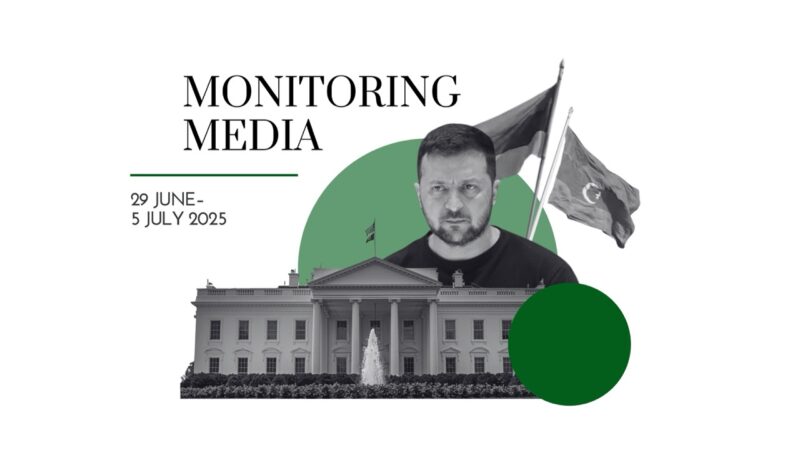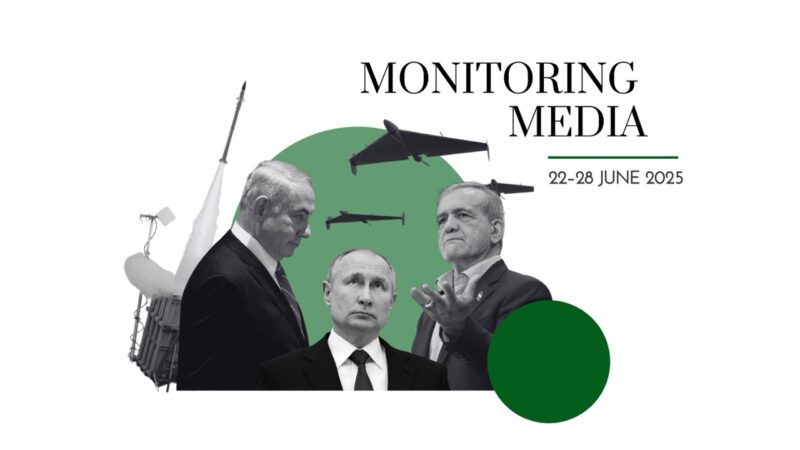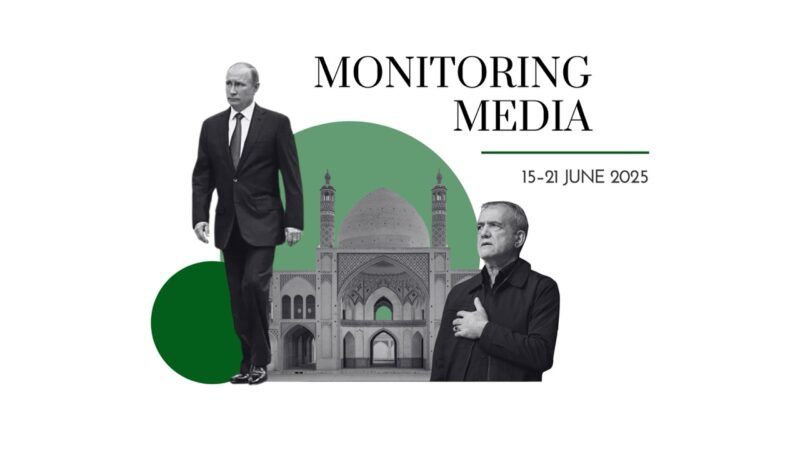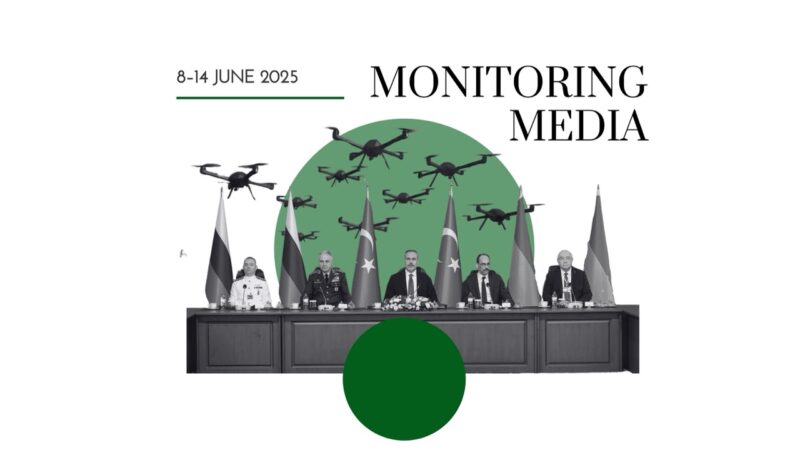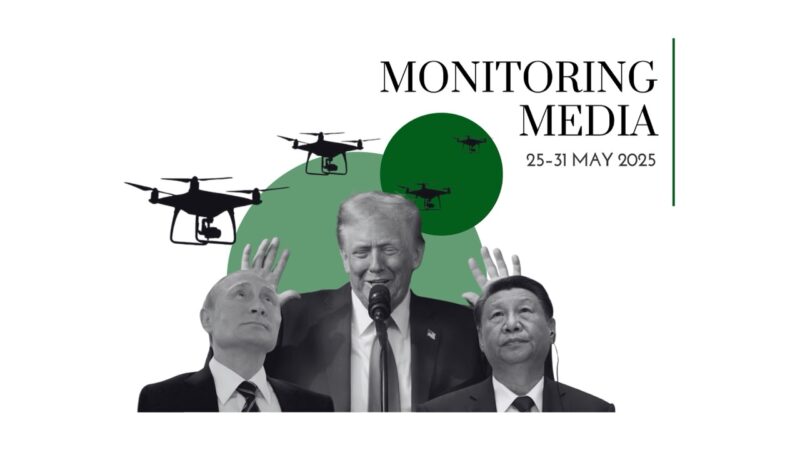The very design of modern warfare has changed

CIUS weekly report on North American media coverage of Ukrainian affairs, 28 January–3 February 2024
Five publications (The National Interest, The Atlantic, CNN, Globe and Mail, and Foreign Affairs) were selected to prepare this report on how Ukraine has been portrayed in the North American press during the past week. The sample was compiled based on their impact on public opinion as well as on their professional reputation, popularity among the readership, and topical relevance. These publications represent centrist viewpoints on the political spectrum.
This report covers only the most-read and relevant articles about Ukraine, as ranked by the respective North American publications themselves in the past week. Its scope covers promoted articles on home pages and articles from special sections on Ukraine, with the hashtag #Ukraine, from the paper editions of the publications, and about Ukraine from opinion columns and editorials.
Topics featured in the selected articles:
- The world and Ukraine: AI drones are the weapon of the future; the design of modern war has changed.
- Russia at war: Moscow’s oil economy is the key to ending Russia’s war against Ukraine; Russian surface fleet is on the verge of extinction.
Main arguments:
Russia’s oil economy must be destroyed. Anders Aslund (National Interest) emphasizes that more effective sanctions combined with Ukrainian drone attacks could bring Russia to its knees. The Russian economy is worth about $1.5 trillion, and the main source of revenue for the Russian budget is the export of raw materials: “The majority of its exports are commodities, especially when petroleum prices are high. Its total export revenues fluctuate with the oil and gas prices from a paltry $382 billion in 2020 to $628 billion in 2022.” Thanks to sanctioning by Western states, Russia has already lost “almost all of its 150 billion cubic meters of gas exports to Europe, worth $60–70 billion a year.” Moscow has not been able to diversify or compensate for the losses in its domestic market, and therefore the Russian monopoly Gazprom “may actually go bankrupt.” Therefore, according to Aslund, it is time for Ukraine’s partners to focus on Russian oil exports. Despite the fact that “in late 2022, the West imposed a price cap on Russian oil,” it is not enough. Western countries should limit the export of raw materials from Russia by blocking sea routes: “Ninety percent of Russia’s oil exports go through two seas, the shallow Baltic Sea and the Black Sea.” The West should also ban Western oil service companies from operating in Russia. These actions can be reinforced by the Ukrainian Armed Forces’ attacks on oil refineries and export ports. Ukraine has so far bombed one of the three major oil ports around “St. Petersburg and one in Tuapse near Novorossiysk.” According to the author, “The Western aim should advance from eliminating Russia’s gas export and cutting the price of its oil exports to eliminating Russia’s exports of oil and petroleum products, which amounted to roughly $230 billion in 2021. Since approximately half of Russia’s total exports consist of oil, effective oil sanctions and Ukrainian bombing could slash off a significant chunk of total exports—$628 billion in 2022 and $460 billion in 2023.”
Is the Russian navy doomed? Robert Farley (National Interest) questions Russia’s ability to rebuild its naval power after the end of war against Ukraine. Russia has actively used naval forces in its aggression against Ukraine to date, with mixed results: on the one hand, Russia blocked Ukrainian ports and launched missile strikes throughout Ukraine; on the other hand, Moscow lost its Black Sea Fleet (BSF) flagship, lost control of Zmiinyi (Snake) Island, and failed in its attempts to conduct amphibious operations on the Ukrainian coast. Although Russia has coped with the effects of sanctions better than expected, Moscow may not be able to restore the strength of its naval forces in the future, or even maintain the existing ones. According to Farley, Russia’s naval situation has also changed significantly over the past few months: “The Baltic [Sea] is, for all intents and purposes, closed to Russia upon the accession of Finland and Sweden to NATO.” Finland’s accession will allow NATO to have improved “eyes on the major Russian naval bases in the Arctic, including the ballistic missile fleet.” At the same time, the power of the BSF in the Pacific is seriously limited by Japan’s rearmament and by growing tensions between Tokyo and Moscow. The Black Sea is extremely dangerous for Russia, given the success of strikes by the Ukrainian Armed Forces as well as the role of Turkey, which “now holds the key to naval power in the Black Sea.” Russia’s problems with its navy extend also to the industrial and technical bases for the production and repair of its ships. Theoretically, Russia could buy warships abroad, but this would require foreign currency and embarrassing public recognition of existing internal problems. However, according to Farley, the objective factors in favour of Russia’s abandonment of naval power may not satisfy Moscow’s ambitions: “On the one hand, Russia enjoys the happy coincidence that its surface fleet cannot survive in nearly any conceivable conflict against a major power and that it likely can no longer afford to build or maintain a surface fleet. On the other hand, President Putin clearly values the prestige and intimidation factor that large, powerful surface ships can offer.”
AI drones are the weapon of the future. Phillips Payson O’Brien (Atlantic) is convinced that drones are the real weapons of artificial intelligence, not nuclear bombs. Unmanned aerial vehicles (UAVs) are changing the nature of warfare, as demonstrated in the Russo-Ukrainian war. This war has accelerated the introduction of artificial intelligence into military affairs: “Each side is deploying millions of [UAVs] to conduct surveillance and attack enemy positions—relying heavily on AI to direct their actions.” As the experience of this war shows, “the real influence of AI lies…in the enabling of thousands of small, conventionally armed systems, each with its own programming that enables it to take on missions without a human guiding its path.” Russia is actively introducing “more AI technology to make these drones operate autonomously.” This is achieved through the use of Western technology, which Moscow obtains by bypassing sanctions. Target-detection technology “allows a drone to sort through the shapes of vehicles and the like that it encounters on its flight.” Ukrainians also use artificial intelligence to protect their sovereignty: “Lieutenant General Ivan Gavrylyuk, the Ukrainian deputy defence minister, recently told a French legislative delegation about his country’s efforts to put AI systems into their French-built Caesar self-propelled artillery pieces.” According to O’Brien, “A highly effective $35,000 AI-guided drone is a bargain by comparison. The fictional WOPR [War Operation Plan Response] almost started a nuclear war, but real-life artificial-intelligence systems keep getting cheaper and more effective. AI warfare is here to stay.”
The design of modern warfare has changed. Valerii Zaluzhnyi (CNN) argues that the design of modern warfare has changed dramatically. However, the concept of victory, regardless of the technical development of weapons and military equipment, remains unchanged: to destroy the enemy and capture/liberate territories. The success of implementing this concept depends on two main factors: (1) technological progress, which determines the development of weapons and equipment; (2) political conditions at home and abroad, as well as the economic environment. Accordingly, winning a war requires a unique strategy that “follows a unique logic.” The strategy of Ukraine’s war against Russia must contend with the following factors: (1) availability of modern weapons, including unmanned systems; (2) reduction “in military support from key allies, [who are] grappling with their own political tensions”; (3) the emergence of new local conflicts, provoked by Russia to distract partners’ attention from supporting Ukraine; (4) “weakness of the international sanctions’ regime”; (5) Moscow’s advantage in mobilization resources; (6) a faulty regulatory framework in Ukraine, as well as partial monopolization of the defence industry. According to Zaluzhnyi, new capabilities should include the integrated use of digital fields and radio-electronic environment control, as well as attack drones and cyber assets, during operations. This will help to minimize human and material losses, reduce reliance on heavy material in combat missions and the overall conduct of hostilities, and expand the scope of damage to enemy targets. Defence systems also need constant improvement, as do countermeasures targeting the use of new technology by the enemy. According to the Commander-in-Chief of Ukraine’s Armed Forces, “In 2024, we must focus our main efforts in three areas. Creating a system to provide our armed forces with high-tech assets. Introducing a new philosophy of training and warfare which takes account of restrictions in assets and how they can be deployed. And mastering new combat capabilities as soon as possible.”
Canadian-owned gold mine in Africa becomes key funding source for Russian military operations in Ukraine. Joseph Coppolino (Globe and Mail) highlights the case of Axmin Inc., a Canadian-owned gold mine in the Central African Republic (CAR), which has become embroiled in a complex dispute involving Russian mercenaries and the CAR government. After being seized by Wagner Group mercenaries, the mine reportedly became a key source of financing for Russia’s military operations globally, including in Ukraine and Africa. Axmin is seeking compensation and a share of the mine’s royalties from the CAR government, which, it alleges, allowed the mercenaries to take control of the mine. Despite legal efforts and international arbitration, the situation remains unresolved, according to Coppolino. The dispute underscores the intricate intersection of geopolitics, resource exploitation, and armed conflict, with Axmin caught in the crossfire between Russian interests and the CAR government. The author quotes John Gravelle, a Canadian member of Axmin’s board of directors, who believes that the CAR government will lose the arbitration case: “They’re going to lose, and then it’s going to be up to them to decide how they’re going to take care of their obligations.” Global Affairs Canada declined to comment on the disputes at the mine, including the Russian takeover, citing “reasons of commercial confidentiality.”
Ukraine’s oligarchs see their once-unassailable status diminish. Eric Reguli (Globe and Mail) argues that the power dynamics surrounding oligarchs in Ukraine have undergone a seismic shift, marked by unprecedented actions against once-untouchable tycoons. The detention of Ihor Kolomoisky (a prominent supporter of President Volodymyr Zelensky) for alleged crimes that include the looting of PrivatBank, coincides with Ukraine’s efforts to combat corruption and align itself more closely with EU standards. This journey, underscored by legislative reforms and intensified anti-corruption measures, has unmistakably eroded oligarchic dominance in both economic and political spheres, Reguli writes. Ukrainian laws enacted during Zelensky’s tenure, such as the “anti-Kolomoisky act” and the “anti-oligarch law,” have curtailed oligarchs’ control over critical industries and media outlets, prompting some to divest their assets or relinquish political positions. Ukraine’s Justice Minister Denys Maliuska states, “The oligarchs’ influence on the government has significantly decreased…. They bribed everyone and were quite ruthless.” Despite progress, though, challenges persist, with corruption scandals continuing to emerge, underscoring the ongoing difficulty in fully rooting out systemic corruption. Nevertheless, Ukraine’s commitment to combating corruption and instituting reforms reflects a broader ambition to bolster its credentials for EU membership. Efforts to cleanse institutions like the judiciary from corruption have entailed dismissals and legislative measures aimed at enhancing transparency and accountability. While Ukraine’s journey towards EU integration faces hurdles, including recent corruption allegations within the defence sector, reducing oligarchic influence in the country has achieved tangible progress.
Unified approach needed among European nations for Kyiv’s survival, Europe’s security. Alina Polyakova and James Goldgeier (Foreign Affairs) suggest that divisions within NATO over Ukraine’s long-term security have become increasingly apparent as the second anniversary approaches of Russia’s invasion of Ukraine. While initial solidarity was evident in the form of military mobilization, aid provision, and refugee support, recent NATO summits have failed to provide a clear path for Ukraine’s accession to the alliance. The reluctance to offer Ukraine membership has emboldened Russia’s President Putin, creating further uncertainty over NATO’s commitment and hindering Western military aid efforts: “NATO’s ambiguity sets up a feedback loop whereby Kyiv’s purported failures—driven, to a large degree, by a lack of adequate Western military aid and lags in the delivery of support—appear to offer evidence that further support in the form of NATO membership would be of little use or might even backfire, forcing the West to become more directly involved in the war.” The authors add that this ambiguity risks prolonging the war and reinforces Putin’s belief that he can outlast the West. Despite Ukraine’s remarkable resistance and the substantial support it has received thus far, including over $200 billion in aid, the lack of a NATO membership offer has created a strategic void that undermines Ukraine’s deterrence capacity. According to Polyakova and Goldgeier, however, “The war in Ukraine has already demonstrated that NATO membership deters Russian attacks on member states’ territory.” Failure to integrate Ukraine into NATO could leave the region vulnerable to further Russian aggression. The upcoming 2024 NATO summit in Washington presents a crucial opportunity to rectify this situation. While immediate membership might not be feasible, initiating accession talks and providing a clear roadmap for Ukraine’s inclusion into the alliance would send a strong signal of support. Without decisive action, the risk increases of prolonged conflict and broader regional instability, underscoring the urgent need for NATO to prioritize Ukraine’s security.
